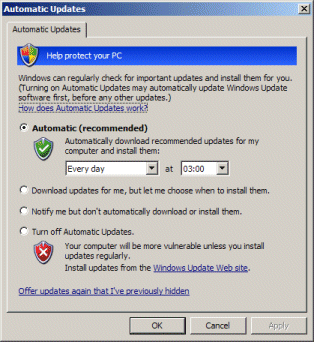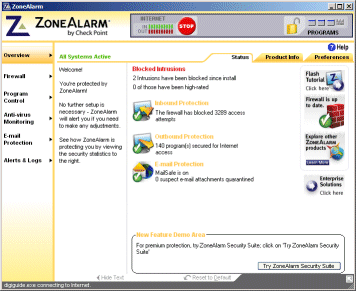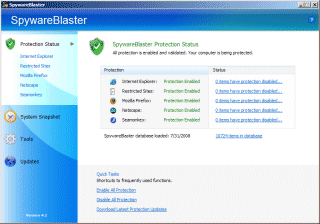Being connected to the internet has – according to various news sources – got more and more dangerous over the years.
A metric that is commonly quoted is the average time it takes for an unprotected PC to become infected by viruses / spyware after it has been connected to the internet.
In 2004 the time was apparently 20 minutes. By 2005 the time had reduced to 12 minutes. Now in 2008 there are articles saying it is 4 minutes.
Whether these stories are true, or just a scare tactics by the anti-virus industry to sell more products is another matter. Whatever the real situation viruses and spyware are real threats and you should make sure you are protected. Becoming infected could lead to personal details being stolen for identity theft purposes, or your bandwidth being stolen for use in botnets.
I use both Windows XP and Internet Explorer and I’ve never had a virus or any spyware on my computer (or at least none that I know of!). Maybe I’m just lucky or maybe it is because I use a variety of tools to stay safe. You can get everything you need to stay safe for free so there is little excuse not to be protected. Here are the tools and techniques I use.
Keep Windows up to date with the latest patches
New patches for Windows are usually released on a monthly basis. Many of these patches stop ‘bad guys’ from taking advantages of newly discovered vulnerabilities in the operating system. Windows can download and install these for you automatically. You should make sure that you computer is configured to do this.
Go to Control Panel -> Security Center.
Make sure that Automatic Updates is turned on. For the easiest updating go into the Automatic Updates settings page and make sure that it is set to download and install them automatically.

Use a firewall
A firewall stops unauthorised connections from coming into your computer. At the very least you should ensure that the default Windows firewall is enabled. As with the Automatic Updates you can check the firewall status from the Windows Security Center (in the Control Panel).
However the Windows firewall only stops unauthorised incoming connections. It won’t stop unauthorised outgoing connections. If you want to do this you should use a more sophisticated firewall such as the free version of the ZoneAlarm firewall. There are several different versions available from their website but the free one will do the job.

You should be warned however that it may well complicate your PC usage as every time a new program tries to access the internet it will ask you if you want to authorise that program. There have also been problems in the past where ZoneAlarm users have lost their internet connections. You will however be more secure if you use ZoneAlarm and if you have problems you can always uninstall it and go back to the default Windows firewall.
You can test how effective you firewall is at stopping incoming connections by using the ShieldsUP! online port scanner. Use their ‘All Service Ports’ scan to see if any of your ports are accessible from outside your computer.
Install a spyware blocker
Some programs will actively search and remove spyware and viruses. Spyware Blaster does something more simple. It sets kill bits for all the spyware programs it knows about so they can’t run.
There is a free version of Spyware Blaster available. You should install it and then run it on a regular basis to download and enable the new spyware updates.

Get an anti-virus application
You should make sure you have an up-to-date anti-virus tool on your computer. Many require you to pay a yearly subscription. avast! antivirus is a commercial tool for business use, but it is free for home use. You can find and download the Home Edition from their official website.
avast! will automatically keep itself up to date if your computer connects to the internet. It will protect you from viruses, spyware and rootkits.
Use a variety of other tools
As well as using a good regular suite of protective tools (firewall, anti-virus, automatic updates) I also on an occasional basis scan my computer using other tools. Not all anti-malware tools find all problems so it is good to use different tools once in a while.
Here are a few that I’d recommend you try:
Ad-Aware – get the free version of this tool to scan for spyware.
Spybot – Search & Destroy – another anti-spyware tool which is worth running once in a while.
Windows Defender – free anti-malware program from Microsoft.
As well as using these application there are a number of online scanners that you can use too:
ZoneAlarm Online Spyware Scanner
Symantec Security Check – virus and security scanner
F-Secure online scanner
Stay safe!



I don’t believe in an unprotected “fresh install” getting infected in a few minutes. If the computer won’t try to send anything to the Internet, nobody will know that the computer exists on the network. I cannot see how other computers on the Internet could know about this one computer if this one computer won’t have any traffic to the Internet at all. So it must send something first for it to have any chance of getting infected.
UNLESS someone manages to somehow scan the IP addresses of the Internet Service Provider and find exactly the one this computer happens to be using at that particular moment. This is extremely unlikely that I think it won’t happen, and it would most likely take much more than a few minutes.